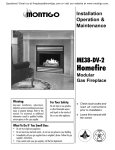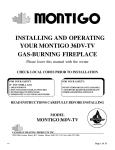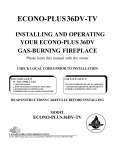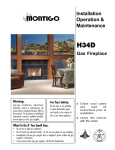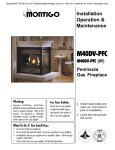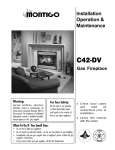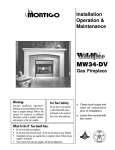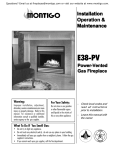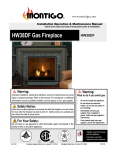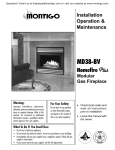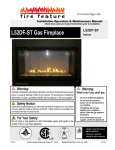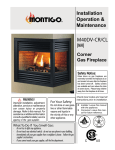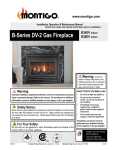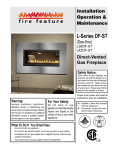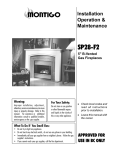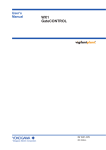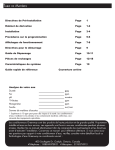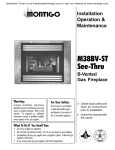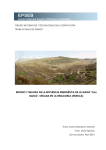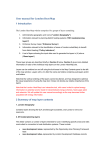Download Montigo ME38-ODV-2 Specifications
Transcript
Installation Operation & Maintenance ME38-ODV-2 Homefire Outdoor Gas Fireplace Safety Notice: Glass doors on gas fireplaces are extremely hot while the fireplaces is on and remain hot even after the fireplace has been turned off. Safety screens are available and can reduce the risks of severe burns. Please keep children away from the fireplace at all times. Warning: Improper installation, adjustment, alteration, service or maintenance can cause injury or property damage. Refer to this manual. For assistance or additional information consult a qualified installer, service agency or the gas supplier. For Your Safety: Do not store or use gasoline or other flammable vapors and liquids in the vicinity of this or any other appliance. Check local codes and read all instructions prior to installation. Installer: Leave this manual with the appliance. Consumer: Leave this manual for future reference. What To Do If You Smell Gas: • Do not try to light any appliance. • Do not touch any electrical switch; do not use any phone in your building. • Immediately call your gas supplier from a neighbor's phone. Follow the gas supplier's instructions. • If you cannot reach your gas supplier, call the fire department. ® C US ME38-ODV-2 Homefire Table Of Contents Introduction About the ME38-ODV-2 Fireplaces: Introduction................................................................................ 2 Installation Installing the Fireplace Shell........................................... 3 Installing the Gasline....................................................... 4 The Remote Switch......................................................... 4 Direct Vent Installation.................................................... 4 General Requirements....................................... 4 Terminations....................................................... 5 Top Vent Models with horizontal runs................. 6 Top Vent Models with vertical runs..................... 8 Rear Vent Models............................................... 9 Construction around the fireplace Facing............................................................... 11 Mantels and Surrounds.................................... 11 The ME38-ODV-2 includes a 22,000 BTU dual burner, and is approved for outdoor use. The ME38-ODV-2 model is available in two versions: Top Vent (Product Code ME38ODT2) Rear Vent (Product Code ME38ODR2) The ME38-ODV-2 is rated for Natural Gas at 22,000 BTU/H (6.45 Kilowatts) Input or Propane at 22,000 BTU/H (6.45 Kilowatts) Input. How to use this manual: This manual covers all models and unless otherwise specified, the designation ME38-ODV-2 refers to all models. Sections which are specific to a particular model are marked with a symbol, plus the appropriate model number. Warranty and Installation Information: The Montigo warranty will be voided by, and Montigo disclaims any responsibility for, the following actions: Modification of the fireplace and/or components including DirectVent assembly or glass doors. Removing and Installing the Insert................................ 12 Removing and Installing the Door................................. 12 Installing the Logset...................................................... 13 Use of any component part not manufactured or approved by Montigo in combination with this Montigo fireplace system. Installing the Trim.......................................................... 13 Installation other than as instructed in this manual. Operation.............................................................................13-14 Maintenance............................................................................. 15 Warranty................................................................................... 16 Appendix A. Termination Locations............................................... 17 For Your Safety Installation and repair should be done by a qualified service person. The appliance should be inspected before use and at least annually by a qualified service person. More frequent cleaning be required as necessary. It is imperitive that control compartment, burners and circulating air passageways of the appliance be kept clean. Page Consult your local Gas Inspection Branch on installation requirements for factory-built gas fireplaces. Installation & repairs should be done by a qualified contractor. Installations in Canada must conform to the current CAN/CGA B-149.1 and .2 Gas Installation Code and local regulations. If the optional air-circulating fan kit is installed, it must be electrically grounded in accordance with CSA C22.1 Canadian Electrical Code Part 1 and/or Local Codes. Installations in the USA must conform to local codes, or in the absense of local codes to the National Fuel Gas Code, ANSI Z223.11988. If the optional air-circulating fan is installed, it must be grounded in accordance with local codes or, in the absence of local codes, with the National Electrical Code, ANSI/NFPA 70-1987. CAUTIONS Due to its high operating temperatures, the appliance should be located out of traffic & away from furniture and draperies. Children and adults should be alerted to the hazards of the high surface temperature, which could cause burns or clothing ignition. Young children should be carefully supervised when they are in the same room as the appliance. Clothing or other flammable materials should not be placed on or near the appliance. Solid Fuel will not be burned in this fireplace. Part No. XG0123 ME38-ODV-2 Homefire Installation Installing The Fireplace Shell The fireplace may be installed in any location that maintains proper clearances to air conditioning ducts, electrical wiring and plumbing. Safety, as well as efficiency of operation, must be considered when selecting the fireplace location. Try to select a location that does not interfere with room traffic, has adequate ventilation, and offers an accessible pathway for Direct Vent installation. Refer to page 4 - Vent Installation for more information. Framing The fireplace dimensions are shown below: 40 3/4 33 5 1/2 15 1/2 14 3/4 Ø4 C * When sheetrock is not used behind the fireplace, framing depth may be reduced to 14 3/4" 37 3/4 Ø7 Figure 2. Framing dimensions. 38 Top Vent 14 3/4 0" clearance to corners only Ø7 Ø4 24 1/8 34 3/4 Front View 28 3/4 Rear Vent Figure 1. Fireplace dimensions. Figure 3. Corner framing dimensions. Clearances These clearances apply to all dimensions except the framed opening, where the clearance to combustibles is 0". The ME38-ODV-2 clearances to combustible materials are: Top - Rear Vent* 7 ¼" Top - Top Vent*** 32" Back 0" Side 1 ½" Floor 0" Mantle** When installing a shelf over the top of the fireplace, the following guidelines must be adhered to: For Rear Vent models (ME38-ODR2), the minimum clearance from the top of the fireplace to a shelf is 7 ¼". For Top Vent models (ME38-ODT-2), the minimum clearance when using the CRS30 is 15". (Minimum 1" clearance must still be maintained around the vent pipes.) 12" * Clearance from the top of the fireplace to a combustible ceiling within the fireplace enclosure. ** Refer to page 10. ***If the standard elbow (MEL90) is used with the Low Clearance Sleeve (CRS30) the Top Clearance is 15". If the Low Clearance Sleeve (CRS30) is NOT used over the elbow, the Top Clearance is 32". Unprotected combustible walls which are perpendicular to the fireplace opening, must not project beyond the shaded area shown in Figure 19b. For protection against freezing temperatures, it is recommended that outer walls of the chase be insulated with a vapour barrier. This will reduce the possibility of a cold-air convection current on the fireplace. Part No. XG0123 43 7/8 Rear Vent Top Vent Figure 4. Framing for shelves over the fireplace. WARNING: When this appliance is installed directly on carpeting, tile or any combustible material other than wood flooring, it must be installed on a metal or wood panel extending the full width and depth of the appliance. Page ME38-ODV-2 Homefire Installation Installing The Gas Line Vent Installation The gas line must be installed before finishing the ME38-ODV-2 Fireplace. Natural Gas requires a minimum inlet gas supply pressure of 5.5" W.C. & a manifold pressure of 3.5" W.C. Propane Gas requires a minimum inlet gas supply pressure of 11" W.C. & a manifold pressure of 10" W.C. Provision must also be made for a 1/8" N.P.T. plugged tapping and be accessible for test gauge connection immediately upstream of the gas supply controls to the appliance. The fireplace gas connection and the main operating gas valve is located behind the removable brass trim at the bottom of the unit and need only be attached to the gas line with an approved fitting, as required by the applicable installation codes. This section covers the installation of direct venting and terminations. Installation Requirements ME38-ODV-2 fireplaces are certified for use with Montigo Standard Series (4" / 7") venting components. Minimum 1" clearance to combustibles required for vent pipes Use only certified Montigo vent components. (Use of other parts will void the Montigo warranty, and may impede the operation of the fireplace.) All joints must be secured with a minimum of two screws per joint Vent terminations must not be recessed in walls or siding Horizontal runs must be supported by a minimum of two supports per horizontal run. A minimum of one screw on each side of support is also required 1 Flex vent sections may be stretched up to 50% of their total length (eg. a 24" section may be stretched to 36") 2 1/2 Gasline access 6 x 2 1/2" Figure 5. Gas line access. The appliance and its individual shutoff valve must be disconnected from the gas supply piping system during any pressure testing of that system at test pressures in excess of 1/2 psig (3.5 kPa). The appliance must be isolated from the gas supply piping system by closing its individual manual shutoff valve during any pressure testing of the gas supply piping system at test pressures equal to or less than 1/2 psig (3.5 kPa). Maximum horizontal run for a flex section with no vertical rise is 3 feet. Flex vent sections over 3 feet must fall within the limits set by the venting graph and must have a minimum vertical rise of 3 inches per foot of flex. Solid vent sections may be cut less than half way from the tapered end Venting components can be used in any combination of solid/rigid pipe or flex pipe and in any orientation (Male connectors can face in any direction) Vent Terminations Selecting A Termination Location Note: After gas line is connected, each appliance connection, valve and valve train must be checked while under normal operating pressure with either a liquid solution, or leak detection device, to locate any source of leak. Tighten any areas where bubbling appears or leak is detected until bubbling stops completely or leak is no longer detected. DO NOT use a flame of any kind to test for leaks. Installing The Remote Switch The ME38-ODV-2's gas valve, located behind the lower brass trim, may be connected to a wall switch. The valve generates its own power on a millivolt circuit. Use only low voltage wire, and DO NOT connect any external power to it. Refer to Figure 26 for wiring requirements. Note: The switch location must not exceed 30' from the fireplace. Choosing your vent termination location will help to determine whether you need to use a top vent or rear vent fireplace. Figure 6, Figure 6. Fireplace locations and vent terminations. Cautions: Vent terminations can be very hot. If the termination is less than 7 feet above a public walkway, it should be fitted with a certified Montigo Heat Guard. (Part no. MTKOG) Do not obstruct, or attempt to conceal, the vent termination. These actions will affect the operation of the fireplace, and may be hazardous. In heavy snow areas, take extra care to prevent snow buildup from obstructing the vent termination. Page Part No. XG0123 ME38-ODV-2 Homefire Installation Installing Terminations with Built-In Frames Installing Heat Guards over Terminations 11 MTO-3F 11 MTKOG 1. Frame the termination opening to 11" x 11". 1. Ensure that the two long mounting brackets are facing the bottom of the termination. (See inset). This will provide more heat protection at the top of the termination, where temperatures are highest. 2. Fasten the termination to the studs using a minimum of 4 screws. Installing Terminations with MSR Frames 12 2. Attach to the faceplate of the termination using four sheet metal screws. MSR MTO-3 12 1. Frame the termination opening to 12" x 12". 2. Fasten the termination to the studs using a minimum of 4 screws. Installing Terminations with MOSR Frames MOSR 12 12 MTO-3 1. Frame the termination opening to 12" x 12". 2. Fasten the MOSR frame to the interior side of the studs using a minimum of 4 screws. 3. Insert the termination into the MOSR frame as shown here, and attach by screwing through the four pilot holes in the termination. Part No. XG0123 Page ME38-ODV-2 Homefire Installation Top Vent Top Vent Venting Runs For the ME38-ODV-2 Top Vent, there are two types of installations: A) Through-The-Wall Installations and B) Vertical (Through-The-Roof) Installations. A) Through-The-Wall Installations Before you install any venting, you must determine whether the venting run will be acceptable. Unacceptable venting can affect the fireplace's combustion. Heat Shields Due to high flue temperatures, heat shields are required on all 38 Series Modular Direct Vent installations (except those with vertical terminations) at the point where the venting connects to the termination. With the heat shield, vent clearances can be maintained at 1". The Venting Graph Measure the vertical height from the fireplace hearth to the centre of the termination and the horizontal run from the from the fireplace flue collar to the wall flange of the termination. Plot on the Venting Graph (Fig. 7) with an 'X'. If the 'X' falls on or above the top boundary of the shaded area, the installation is acceptable. Example A: (Acceptable Installation) If the vertical dimension from the hearth is 84" and the horizontal run to the wall flange of the vent termination is 36", this would be an acceptable installation. Example B: (Acceptable Installation) If the vertical dimension from the hearth is 90" and the horizontal run to the wall flange of the vent termination is 120", this would be an acceptable installation. Example C: (Unacceptable Installation) If the vertical dimension from the floor of the fireplace is 72" and the horizontal run to the wall flange of the vent termination is 84", this would not be an acceptable installation. 108 96 84 72 60 48 36 Figure 8. Heat Shield. Install by sliding over the vent pipe where it passes through combustible construction. Available Top Vent Components The following venting components are available for the ME38-ODV-2 Top Vent: A - Termination B - Stucco Kits MTO-3 (3" length) MTO-3F (3" length) MSR (stucco frame) MOSR (stucco can) BSR (brick can) D - Flex sections MFL-1 (12" section) MFL-18 (18" section) MFL-2 (24" section) MFL-3 (36" section) MFL-4 (48" section) E - Solid sections F - Elbows EXT-18 (18" f/f section) MEXT-1 (12" m/f section) MEXT-2 (24" m/f section) MEXT-3 (36" m/f section) MEXT-4 (48" m/f section) MEL-90M (m/m 90° elbow) MEL-90F (f/f 90° elbow) MEL-90FM (f/m 90° elbow) EEL-45 (f/m 45° elbow) 24 12 0 0 Hearth 12 24 36 48 60 72 84 96 108 120 132 144 156 168 180 Figure 7. Venting Graph Page Horizontal Run (in.) NOTES: All dimension lengths for vertical or horizontal runs are measured from center of the vent pipe. Venting runs must fall within the limits set by the venting graph (see Figure 7). Part No. XG0123 ME38-ODV-2 Homefire Installation Top Vent Example 1: 150" max. 30" max. For our shortest venting configuration use components A and F (see Figure 9a). Heat Shield Termination Termination Solid Sections Heat Shield Exterior Wall MEL-90F/F Elbow Flex Section Hearth Figure 9a. Typical Top Vent installation. If the 90° elbow is installed directly on the fireplace, the height to the center of the termination is 44". Horizontal Venting Figure 10. Extended Installation using a combination of solid and flex venting. Use the vent graph to determine your allowable run, then select appropriate components. Heat Shield 90° Elbow Solid Sections Heat Shield Termination Flex Section Exterior Wall MEXT Section Hearth Termination Figure 11. Retracted Installation using a combination of solid and flex venting. Use the vent graph to determine your allowable run, then select appropriate components. Figure 9b. Typical Top Vent installation. The solid sections can be used in various combinations to obtain the desired vent run. The vent run must fall within the limits set by the venting graph. Example 2: 3' max. Flex Section A 10' section and elbow (MIHR-10) used in conjunction with 3 ft. flex section (MFL-3) will, when extended in a five foot chase, allow for a maximum horizontal run of twelve and one-half feet from the centre of the fireplace to outside wall and a minimum of 7'6" when retracted in opposite direction (see Figure 10 and 11). "D" flex sections and "E" solid sections may be used in conjunction with one another to obtain different possible horizontal length installations. NOTE: Flex section with no vertical rise must not exceed maximum horizontal length of 3 feet (see Figure 12). Flex runs over 3 feet must fall within the limits set by the venting graph, and must have a minimum vertical rise of 3" per foot of flex. Part No. XG0123 Heat Shield Termination Hearth Exterior Wall Figure 12. Horizontal flex installation with no vertical rise. Page ME38-ODV-2 Homefire Installation B. Vertical (Through-The-Roof) Installations Vertical Terminations must be installed: • minimum 2' (two feet) above the highest point where vent passes through the roof. • minimum 6' (six feet) from a mechanical air inlet • minimum 18" (1 1/2 feet) from a parapet wall. Maximum vent height is 35 feet above fireplace. Note: Flame characteristics will change if the maximum vent height is used. Top Vent A maximum of two offsets (each offset has two 90° bends) may be made and shall not exceed total length of 25% of the vertical vent height, when measured center to center of piping. Example: Typical vent installation. 20' vertical vent 2 - 2' offsets required 25% of 20' = 5' max. offset allowed This venting configuration meets requirements. Minimum clearances 1" from vent to all combustible materials must be maintained. A - Termination MVTK-1 B - Flex sections MFL-1 (12" section) MFL-2 (24" section) MFL-3 (36" section) MFL-4 (48" section) MEXT-1 (12" section) MEXT-2 (24" section) MEXT-3 (36" section) MEXT-4 (48" section) MSPXT-8 (7" dia.) C - Solid sections D - Support Ring & Plate E - Firestop FS-7 (7" dia.) F - Roof Flashing MRF-7 (1/12 - 7/12 pitch) MRF-12 (7/12 - 12/12 pt.) MRF-16 (12/12 - 16/12 pt.) Storm collar 2' min. Roof flashing Support ring 30'max. max. 35' Support plate Firestop * Minimum 1" clearance to all combustibles Figure 14a. Vertical venting with 1 offset (1 offset= two 90° bends). Storm collar 2' min. Roof flashing Storm collar Roof flashing Support straps or support plate & ring 2' min. Firestop MEXT Solid Section Firestop 35' 30' max. max. Support plate & ring Support ring 35' 30'max. max. Support plate MEXT Firestop MXT-10 Adaptor Firestop 2' Firestop Flue Collar * Minimum 1" clearance to all combustibles Figure 13. Straight, vertical venting using required MXT-10 adaptor. Page * Minimum 1" clearance to all combustibles Figure 14b. Vertical venting with 2 offsets (1 offset= two 90° bends). Part No. XG0123 ME38-ODV-2 Homefire Installation Rear Vent Rear Vent Venting Runs The ME38-ODV-2 Rear Vent has three possible installations which do not require vertical lift: 2. 45° Corner Installation. 1. Straight Installation. The height from the hearth to the center of the termination is 28 ¾". ME38-ODV-2 Rear Vent versions are supplied with an 18" extension pipe (EXT-18) with female/female connections. For shorter installations, cut the EXT-18 to the desired length. Attach an EEL-45 (45° elbow) directly onto the flue collar. Cut the EXT-18 to suit, and attach it to the EEL-45. Slide the fireplace into position and attach to the termination. Termination Heat Shield EXT-18 For extended installations, use the EXT-18 section as supplied for an 18" vent run. Note: EEL-45 Elbow For Rear Vent models, maximum horizontal run with no vertical lift must never exceed 18". Flue Collar Heat Shield EXT-18 Flue Collar Figure 16. Corner installation. 3. Corner Installation - 45° or less. Use an MTO-3 termination and an MFL-1 or MFL-18 (12" or 18" compressed length) and a frame, if appropriate. Flex may be turned to obtain desired degree of angle required but must not exceed 45°. Termination Termination Heat Shield Figure 15. Extended installation. Flex Section Flue Collar Figure 17. Flex installation. Heat Shields Due to high flue temperatures, heat shields are required on all ME38ODV-2 installations (except those with vertical terminations) at the point where the venting connects to the termination. With the heat shield, vent clearances can be maintained at 1". See Figure 8. Part No. XG0123 Page ME38-ODV-2 Homefire Installation B. Multi-Elbow Installations For more diffiicult installation situations, the ME38-ODV-2 Rear Vent may be installed with two - 90° elbows and up to 15' of horizontal run. If using this installation option, you must adhere to the following guidelines: the first 90° elbow must be placed directly on the flue collar you must have a minimum vertical lift of 50" (measured from the hearth) your vent run must fall within the limits set by Figure 18a Before you install any venting, you must determine whether the venting run will be acceptable. Unacceptable venting can affect the fireplace's combustion. The Venting Graph Measure the vertical height from the fireplace hearth to the centre of the termination and the horizontal run from the from the fireplace flue collar to the wall flange of the termination. Plot on the Venting Graph (Fig. 18a) with an 'X'. If the 'X' falls on or above the top boundary of the shaded area, the installation is acceptable. Example A: (Acceptable Installation) If the vertical dimension from the hearth is 84" and the horizontal run to the wall flange of the vent termination is 36", this would be an acceptable installation. Example B: (Acceptable Installation) If the vertical dimension from the hearth is 90" and the horizontal run to the wall flange of the vent termination is 126", this would be an acceptable installation. Rear Vent Installation Of Rear Vent DV ME38-ODV-2 Rear Vent versions are supplied with an EXT-18 (female/female) section. In addition, the following venting components are available for Rear Vent installations: A - Termination MTO-3 (3" length) MTO-3F (3" length) B - Stucco Kits MSR (stucco frame) BSR-4 (4" brick frame) BSR-6 (6" brick frame) MOSR (stucco can) D - Flex sections MFL-1 (12" section) MFL-18 (18" section) MFL-2 (24" section) MFL-3 (36" section) MFL-4 (48" section) E - Solid sections F - 90 degree elbow MEXT-1 (12" section) MEXT-2 (24" section) MEXT-3 (36" section) MEXT-4 (48" section) MEL-90M (m/m 90° elbow) MEL-90F (f/f 90° elbow) MEL-90FM (f/m 90° elbow) EEL-45 (f/m 45° elbow) NOTES: All dimension lengths for vertical or horizontal runs are measured from center of the vent pipe. Venting runs must fall within the limits set by the venting graph (see Figure 18a). Example C: (Unacceptable Installation) L If the vertical dimension from the floor of the fireplace is 78" and the horizontal run to the wall flange of the vent termination is 108", this would not be an acceptable installation. H 108 96 8" 84 72 60 min 8" max 18" 48 36 Figure 18b.Multi-elbow installation. Distance 'H' must be a minumum of 50". The vent run must comply with figure 18a. 24 12 0 0 Hearth 12 24 36 48 60 72 84 96 108 120 132 144 156 168 180 Horizontal Run (in.) Figure 18a. ME38-ODV-2 Rear Vent Venting Graph Page 10 Part No. XG0123 ME38-ODV-2 Homefire Installation Finishing Around the Fireplace Combustible mantels and mouldings may be safely installed over the top and on the front of the fireplace provided that they do not project beyond shaded area shown in Figure 19a. Side wall clearances are 3". Combustible surrounds may be installed with 3" clearance to the side of the fireplace as shown in Figure 19b. Fireplace Facing When selecting the finish material for your fireplace, it is important to remember the following: TRIMS MUST NOT BE OBSTRUCTED IN ANY WAY - to do so restricts the air supply for the control compartments and heat exchanger it also prevents access for servicing controls. Special care is recommended by the Master Painters and Decorators Association, when painting the fireplace surrounds, to select and apply a quality Alkyd sealer prior to the applying of latex paints. This is to prevent leaching of water from evaporation and causing a brownish staining effect to paint over coats. Sheetrock/ Drywall Header The face of the fireplace may be painted to match the room decor, provided you use a heat-resistant paint. Decorative facing must not extend past the fireplace opening at all, because it will interfere with the access to retainers for removal of glass door. 45° Combustible construction allowed in shaded area. 3 Combustible Facing Figure 19b. Combustible surrounds. Top of fireplace 12 11 10 9 8 7 6 5 4 3 2 1 Figure 19a. Combustible mantles and facings. Mantels & Surrounds NOTE: National Canadian Gas Association mantel test requirements are for fire hazard prevention to combustible materials. New technology, to meet consumer and government demands for the wise use of energy, has prompted us to manufacture many models of fireplaces which are hot, fuel and energy efficient. Please be aware; temperatures over the mantel will rise above normal room temperature and walls above fireplace may be hot to touch. We recommend careful consideration be given to the effects of elevated mantel temperatures which may be in excess of product design, for example: candles, plastic or pictures. This can cause melting, deformation, discoloration or premature failure of T.V. and radio components. Painting: Part No. XG0123 Page 11 ME38-ODV-2 Homefire Installation Removing and Installing the Door Removing and Installing the Insert You may remove the insert to protect it from theft and damage during construction. 1. Remove the two machine screws (1 left & 1 right) at the top of the insert that attach the insert to the shell. See Inset 1. 2. Remove the fresh air flex from the collars on the shell. See Figure 22. Important: Be careful not to damage the fresh air flex during removal or storage. Removing the Door: Remove the trim (as described on the next page) to access the door latches. Open the latches by pulling Part A upwards and towards you to disengage Part B from the door. Lift Part B clear of the door. Repeat for all three latches. Be sure to hold the door carefully so it does not fall. (See figure 23a.) 3. Remove the 4 machine screws that hold the venting plate to the insert. 4. Remove the insert by tipping the top of the insert outward and lifting the tabs past the slots in the bottom of the shell. See Inset 2. Store the screws and clamps in a safe place to ensure that they are not lost. To re-install the insert simply reverse the steps above. Mounting Bracket Figure 23a. Operating the door latches. Tab INSET 1 INSET 2 Front Slot High temp. silicone seal Fresh Air Flex (4" dia.) Venting Plate Figure 22. ME38-ODV-2 insert. Page 12 Figure 23b. Removing the door. Once the three latches are unhinged, tilt the top of the door forward and lift it out of the slots. See figure 23b. Part No. XG0123 ME38-ODV-2 Homefire Installation Installing the Log Set Installing the Logs: The ME38-ODV-2 is supplied with six ceramic fibre logs. Unpack the logs and handle them very carefully. 1. Remove the door cover and the glass door. Installing the Trim The fireplace is shipped with 6 horizontal trim pieces (3 upper and 3 lower), which must be field-installed. Install the trim by placing the top edge of the trim over to the retainer clips on either side of the fireplace. Push the bottom edge firmly inwards and the trim will snap on. (See figure 25) 2. Place the Back log onto the back log rest as shown below in figure 24a. The log has lip on the bottom which fits into the slot on the log rest. Figure 24a.Positioning for the front and back logs. 3. Place the Front log onto the front log rest as shown in figure 24a. Center the log from side to side, and push it against the back of Log 'A' the log rest. Carefully push the log onto the metal spikes on the log rest. 4. Place the top logs in position as shown in figure 24b. 5. Start the fireplace. If the flame appears satisfactory, replace the Log 'D' Log 'E' glass door and door cover. NOTES: If logs are not placed properly, excessive sooting will result. The surface of the logs will crack due to the heat from the flames. This is a normal occurance. Figure 25. Installing the horizontal trim pieces. Operation Lighting Instructions It is recommended that the burner is inspected each time beforeusing this appliance. See page 14. Burner Adjustment The ME38-ODV-2 fireplace is equipped with an adjustable burner, allowing you to raise or lower the flames. Operating the control knob Log 'B' Log 'C' as described below will adjust both the main burner and the ember burner. To raise the flame height, turn the black knob (located behind the lower trim) counterclockwise. To lower the flame height, turn clockwise. 'Hi-Lo' Adjustment Knob Gas Control Knob (Shown in "Pilot" postion.) Figure 24b.Proper log placement . (No embers on ME38-ODV2) Part No. XG0123 Figure 26. 'Hi-Lo' Adjustment on the ME38-ODV-2's gas valve. Page 13 ME38-ODV-2 Homefire ME38-ODV-2 Operation - Model ME38-ODV-2 with Continuous Pilot For Your Safety - READ BEFORE LIGHTING: WARNING: If you do not follow these instructions exactly, a fire or explosion may result causing property damage, personal injury or loss of life. A. This appliance has a pilot which must be lighted by hand. When lighting the pilot, follow these instructions exactly. B. BEFORE LIGHTING smell all around the appliance area for gas. Be sure to smell next to the floor because some gas is heavier than air and will settle on the floor. What To Do If You Smell Gas: Do not try to light any appliance. Do not touch any electrical switch; do not use any phone in your building. Immediately call your gas supplier from a neighbour's phone. Follow the gas supplier's instructions. If you cannot reach your gas supplier, call the Fire Department. C. Use only your hand to push in or turn the gas control knob. Never use tools. If the knob will not push in or turn by hand, don't try to repair it, call a qualified service technician. Force or attempt to repair may result in a fire or explosion. D. Do not use this appliance if any part has been under water. Immediately call a qualified service technician to inspect the appliance and to replace any part of the control system, and any gas control which has been under water. Lighting Instructions: STOP! Read the safety information above on this label. Flip down lower trims. Push in gas control knob and turn clockwise to "OFF." Wait five (5) minutes to clear out any gas. Smell for gas, including near the floor. If you then smell gas, STOP! Follow "B" in the safety information above on this label. If you don't smell gas, go to the next step. 5. Locate pilot burner (See illustration at right.) and follow steps below. 6. Turn knob on gas control counterclockwise to "PILOT." 7. Push in gas control knob completely and hold. Light with 1. 2. 3. 4. Gas Control Knob (Shown in "Pilot" postion.) Piezo Igniter button. Continue to hold the control knob in for about (1) minute after the pilot is lit. Release the knob and it will pop back up. Pilot should remain lit. If it goes out repeat steps 3 through 8. If knob does not pop up when released. Stop and immediately call your service technician or gas supplier. If the pilot will not stay lit a f t e r s e v e r al tries, turn the gas control knob to "OFF" and call your service technician or gas supplier. 8. Push in gas control knob and turn counterclockwise to "ON." 9. Flip up lower trim. 10.Turn on remote switch to ignite fire. NOTE: Knob cannot be turned from "PILOT" to "OFF" unless knob is pushed in slightly. Do not force. To Turn Off Gas To Appliance: 1. Turn off remote switch. 2. Flip down lower trim. 3. Push in gas control knob slightly and turn to "Off". Do not force. clockwise 4. Flip up lower trim. Page 14 Part No. XG0123 ME38-ODV-2 Homefire Maintenance Gas Control Valve CAUTIONS Fireplace gas control must be in the “OFF” position and pilot and main burners extinguished when cleaning appliance with a vacuum. Power Generator Pilot Adjustment Screw Doors and logs can get very hot. Handle only when cool. Wall Switch General Have the fireplace installation inspected yearly, including a visual check of the vent system, the burner and the pilot flame. For your convenience a 1/8" manifold pressure tap is supplied on the gas valve for a test gauge connection. See Figure 26. For Natural Gas this appliance requires a minimum inlet pressure of 5.5" W.C. and a manifold pressure of 3.5" W.C. For Propane Gas this appliance requires a minimum inlet pressure of 11" W.C. and a manifold pressure of 10" W.C. Always keep the fireplace area clear and free of combustible materials, as well as gasoline and other flammable vapours and liquids. Do not use this appliance if any part has been under water. Immediately call a qualified service technician to inspect the appliance and to replace any part of the control system and any gas control which has been under water. Inlet Pressure Manifold Pressure Test Connection Figure 27. Sit Nova 820 gas valve. Pilot Burner Adjustment 1. Locate Pilot Adjustment Screw. (See figure 27.) 2. Adjust pilot screw to provide properly sized flame as shown in figure 28). 3. After installing or servicing, leak test with a soap solution with main burner on. Coat pipe and tubing joints, gasket etc. with soap solution. Bubbles indicate leaks. Tighten any areas where the bubbles appear until the bubbling stops completely. Cleaning When the fireplace is first activated, there may be some smoking and a visible film may be left on the glass. This is a normal condition, and is the result of burning of protective coatings on new metal. Glass must be cleaned periodically to remove any film (which is a normal biproduct of combustion) which may be visible. Film can easily be removed by removing the door, as shown on page 13. Handle the door carefully, and clean it with non-abrasive glass cleaners. One of the most effective products is Kel Kem. Silicone seals on inner door during initial firing will "off gas", leaving a visual deposit of a white substance on combustion chamber walls. This can easily be removed using normal household products. Use a vacuum cleaner or whisk broom to keep the control compartment, burner, and firebox free from dust and lint. Logs may be cleaned periodically with a vacuum to remove soot WARNING: Do not attempt to clean glass when hot. Figure 28. Pilot Burner Troubleshooting The following is a troubleshooting chart of possible problems: PROBLEM CORRECTIVE ACTION Noisy Pilot Flame Locate pilot adjustement screw on gas control valve. Flame is decreased by turning adjustment screw clockwise. Pilot won’t ignite Disconnect remote wires and try to light pilot. If pilot now works, remote connections are faulty. Check wiring diagram figure 27. Main burner will not light 1. Check wiring (see figure 27). 2. Check wall switch for proper connection. Do not clean glass with abrasive materials as any glass etching may cause premature glass failure. Part No. XG0123 ME38-ODV-2 Page 15 ME38-ODV-2 Homefire Warranty The Warranty The Companies warrants the Montigo Gas Appliance to be free from defects in materials and workmanship at the time of manufacture. On the Montigo, there is a ten-year warranty on the firebox and its components, a five-year warranty on the main burner and pilot burner, and a one-year warranty on the gas control valve and fibre logs. Glass, plated/painted finishes, and refractory lining are exempt. Remedy And Exclusions The coverage of this Warranty is limited to all components of the Gas Appliance manufactured by The Companies. This Warranty only covers Montigo Gas Appliances installed in the United States or Canada. If the components of the Gas Appliance covered by this Warranty are found to be defective within the time frame stated (see The Companies right of investigation outlined below). The Companies will, at its option, replace or repair defective components of the Gas Appliance manufactured by The Companies at no charge, and will also pay for reasonable labour costs incurred in replacing or repairing components. If repair or replacement is not commercially practical, The Companies will, at its option, refund the purchase price of the Montigo Gas Appliance. This Warranty covers only parts and labour as provided above. In no case shall The Companies be responsible for materials, components, or construction which are not manufactured or supplied by The Companies, or for the labour necessary to install, repair or remove such materials, components or construction. All replacement or repair components will be shipped F.O.B. the nearest The Companies factory. Qualifications To The Warranty The Gas Appliance Warranty outlined above is further subject to the following qualifications: (1) The Gas Appliance must be installed in accordance with The Companies installation instructions and local building codes. The Warranty on this Montigo Gas Appliance covers only the component parts manufactured by The Companies. The use of components manufactured by others with this Montigo Gas Appliance could create serious safety hazards, may result in the denial of certification by recognized national safety agencies, and could be in violation of local building codes. This warranty does not cover any damages occurring from the use of any components not manufactured or supplied by The Companies (2) The Montigo Gas Appliance must be subjected to normal use. The Gas Appliances are designed to burn gas only. Burning conventional fireplace fuels such as wood, coal or any other solid fuel will cause damage to the Gas Appliance, will produce excessive temperatures and will result in a fire hazard. Limitations On Liability It is expressly agreed and understood that The Companies sole obligation, and purchaser's exclusive remedy under this Warranty, under any other warranty, expressed or implied, or in contract, tort or otherwise, shall be limited to replacement, repair, or refund, as specified above. In no event shall The Companies be responsible for any incidental or consequential damages caused by defects in its products, whether such damage occurs or is discovered before or after replacement or repair, and whether or not such damage is caused by The Companies negligence. Some states do not allow the exclusion or limitation of incidental or consequential damages, so the above limitation or exclusion may not apply to you. The duration of any implied warranty with respect to this Montigo Gas Appliance is limited to the duration of the foregoing warranty. Some states do not allow limitation on how long an implied warranty lasts, so the above may not apply to you. Investigation Of Claims Against Warranty The Companies reserves the right to investigate any and all claims against this Warranty and to decide upon method of settlement. The Companies Are Not Responsible For Work Done Without Written Consent The Companies shall in no event be responsible for any warranty work done without first obtaining The Companies written consent. Dealers Have No Authority To Alter This Warranty The Companies employees and dealers have no authority to make any warranties nor to authorize any remedies in addition to or inconsistent with those stated above. How To Register A Claim Against Warranty In order for any claim under this Warranty to be valid, The Companies must be notified of the claimed defect in writing or by telephone, as soon as reasonably possible after the defect is discovered. Claims against this Warranty in writing should include the date of installation, and a description of the defect. Other Rights Canadian Heating Products Inc. and/or Montigo DelRay Corp. reserves the right to make changes at any time, without notice, in design, materials, specifications, prices and also to discontinue colors, styles and products. Page 16 Part No. XG0123 ME38-ODV-2 Homefire Appendix A - Termination Locations A = clearance to the termination frame above grade, veranda, porch, deck, or balcony [16 inches (41 cm) minimum] B = clearance to door, or sides and top of window, that may be opened [16 inches (41 cm) minimum for appliances ≤100 000 BTU/H (30kW)] C = clearance to bottom of window that may be opened horizontally [36 inches (92 cm) minimum for appliances ≤100 000 BTU/H (30kW)] D = no clearance to permanently closed window when installed with approved glass penetration termination E = clearance to permanently closed window [16 inches 41 cm recommended to prevent condensation on window] F = vertical clearance to ventilated soffit located above the termination within a horizontal distance of 2 feet (61 cm) from the centreline of the termination [22 inches (56 cm) minimum] G = clearance to unventilated soffit [16inches (41 cm) minimum to non-combustibles] [22 inches (56 cm) minimum to combustibles] H = clearance to outside corner [9 inches (23 cm) minimum] I = clearance to inside corner [12 inches (31 cm) minimum] J = * not to be installed above a meter/regulator assembly within 40" (103 cm) horizontally from the centreline of the regulator K = clearance to service regulator vent outlet [3 feet minimum in the United States] [*6 feet (1.8 m) minimum in Canada] [*6 feet (1.8 m) minimum] N = † clearance above paved sidewalk or a paved driveway located on public property [*7 feet (2.1 m) minimum] P = clearance under veranda, porch, deck, or balcony [16 inches (41 cm) minimum‡ to non-combustibles] [22 inches (56 cm) minimum‡ to combustibles] Q = clearance above a roof [24 inches (61 cm) minimum] R = clearance to adjacent walls and neighbouring buildings [18 inches (46 cm) minimum] S = clearance from corner in recessed location [12 inches (31 cm) minimum] T = maximum depth in recessed location [48 inches (122 cm) minimum] U = minimum width for back wall of recessed location [24 inches (61 cm) minimum] V = no horizontal clearance between the frames of two terminations that are level. W = horizontal clearance between the frames of two terminations that are not level. [36 inches (92 cm) minimum] † a vent shall not terminate directly above a sidewalk or paved driveway which is located between two single family dwellings and serves L = clearance to nonmechanical air supply inlet to building or the combustion air inlet to any other appliance [16 inches (41 cm) minimum for appliances ≤100 000 BTU/H (30kW)] M = clearance to mechanical air supply inlet both dwellings only permitted if veranda, porch, deck, or balcony has an open side that is equal to or greater than the depth of the enclosed area * as specified in CGA B149 Installation Codes. Note: local Codes or Regulations may require different clearances ‡ Part No. XG0123 Page 17 XG0123 - 011707 Canadian Heating Products Inc. Montigo Del Ray Corp. Langley, BC V4W 4A1 Ferndale, WA 98248


















